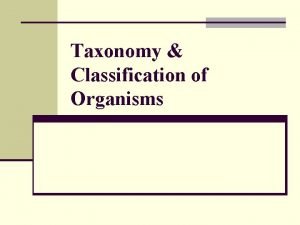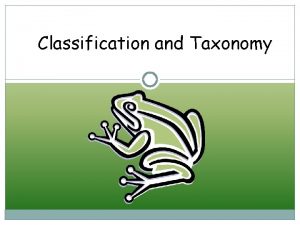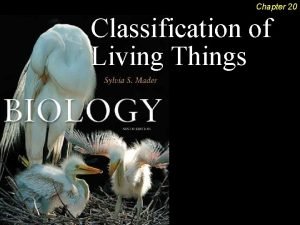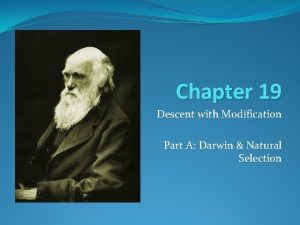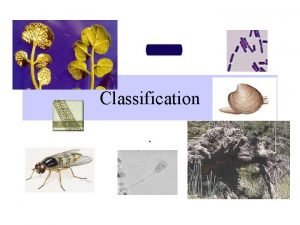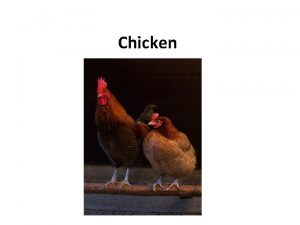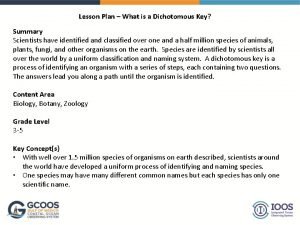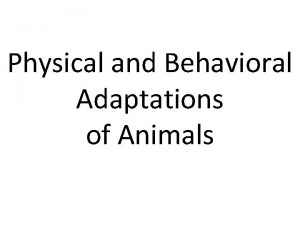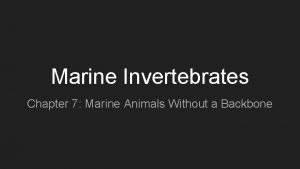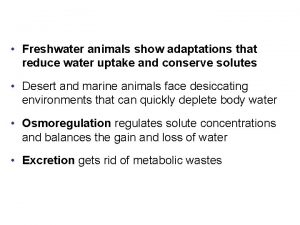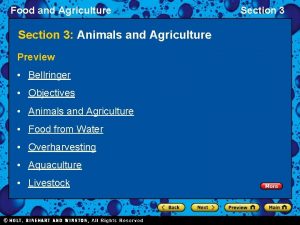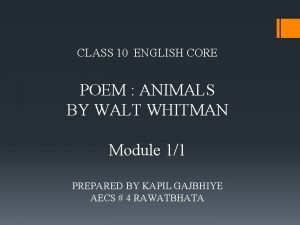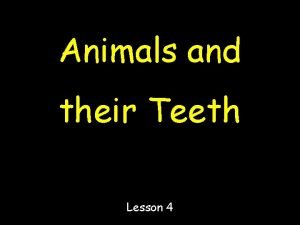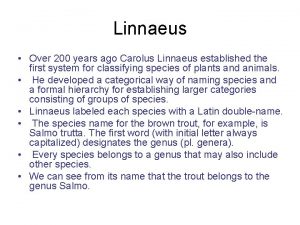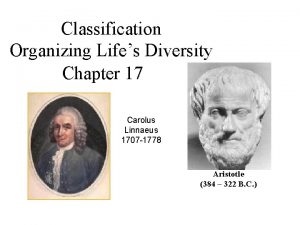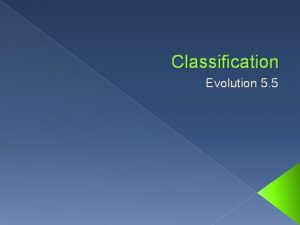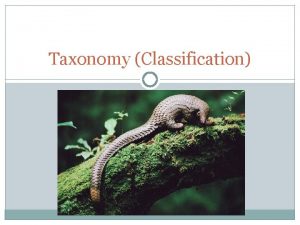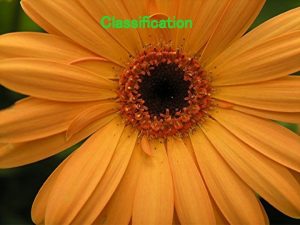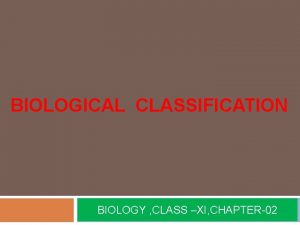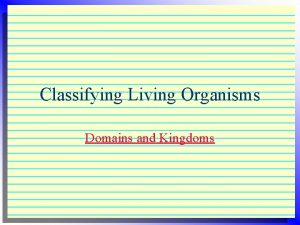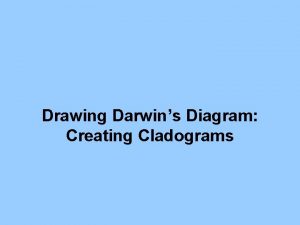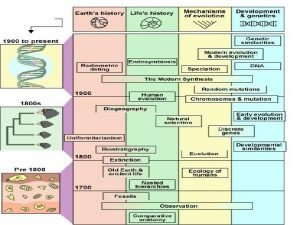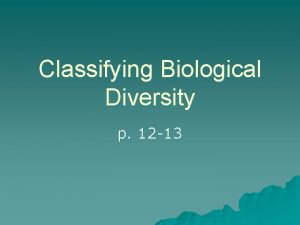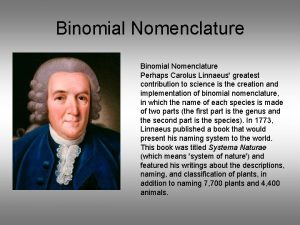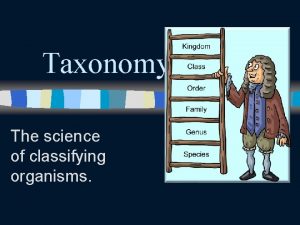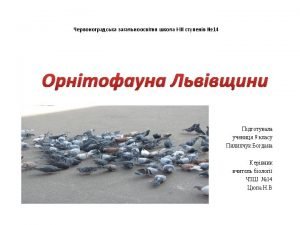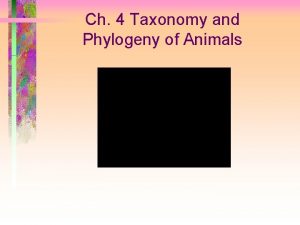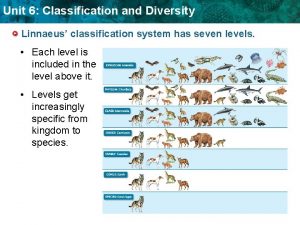Classification of Animals Linnaeus and Classification Carolus Linnaeus

































- Slides: 33

Classification of Animals

Linnaeus and Classification • Carolus Linnaeus designed our classification scheme. – Kingdom – Phylum – Class – Order – Family – Genus – Species

Linnaeus and Classification • All animals are placed in Kingdom Animalia. • Names of animal groups at each rank in the hierarchy are called taxa (taxon). – Each rank can be subdivided into additional levels of taxa. • Superclass, suborder, etc.

Animal Taxonomy • Linneus classified species as the smallest unit, and that each species nested within a higher category • Species is a Latin word meaning “kind” or “appearance • Differentiation between species based on: a) Morphological differences b) For each species, the potential to interbreed its individuals with each other in nature to produce fertile offspring

Binomial nomenclature • Linneus developed the concept of binomial nomenclature, whereby scientists could communicate clearly. • Under the binomial system, each species is assigned a twopart latinized name, (a binomial) 1. The first part, the genus ﺍﻟﺠﻨﺲ , is the group to which a species belongs. 2. The second part, refers to the species ﺍﻟﻨﻮﻉ within the genus. The first letter of the genus is capitalized and both names are italicized and latinized. For example, Linnaeus assigned to humans the scientific name Homo sapiens, which means “wise man”.


Phylum Annelids

Different Phyla of Non-chordates and their examples 1 -Phylum: Porifera: ﺍﻻﺳﻔﺘﺠﻴﺎﺕ Dermal ostia ﻓﺘﺤﺎﺕ and canal system are present. E. g. Sycon , Porifera: Sycon

2 -Phylum- Coelenterata or Cnidaria ﺍﻟﺠﻮﻓﻤﻌﻮﻳﺎﺕ They possess cells called cnidoblasts ﻻﺳﻌﺔ ﺧﻼﻳﺎ for defense and food capture. e. g. Hydra, Hydra


3. Phylum- Ctenophora ﺍﻟﻤﺸﻄﻴﺎﺕ : They possess external rows of comb plates for locomotion. E. g. Pleurobranchia Ctenophora: Pleurobranchia

4. Phylum- Platyhelminthes ﺍﻟﺪﻳﺪﺍﻥ ﺍﻟﻤﻔﻠﻄﺤﺔ • They have flat body. • Flame cells are present for excretion. • E. g. Taenia

5. Phylum- Aschelminthes ﺍﻟﺪﻳﺪﺍﻥ ﺍﻟﺨﻴﻄﻴﺔ : They are cylindrical, elongated and wormshaped. E. g. Ascaris (Roundworm),

6. Phylum- Annelida : - ﺍﻟﺪﻳﺪﺍﻥ ﺍﻟﺤﻠﻘﻴﺔ Their body exhibits true segmentation (metamerism) e. g Earthworm

7. Phylum- Arthropoda ﺍﻻﺭﺟﻞ ﻣﻘﺼﻠﻴﺎﺕ : They have paired, jointed appendages Having chitinous exoskeleton. E. g. Honey bee

8. Phylum- Mollusca ﺍﻟﺮﺧﻮﻳﺎﺕ : - They are soft-bodied animals which generally possess calcareous shell as exoskeleton. e. g Octopus

9. Phylum-Echinodermata ﺍﻟﺠﻠﺪ ﺷﻮﻛﻴﺎﺕ : • They are spiny-skinned animals • having radial symmetry in adult stage. • They possess water vascular system. E. g. Star fish

10. Phylum- Hemichordata ﻧﺼﻔﻴﺔ ﺍﻟﺤﺒﻞ • They are worm-like animals with proboscis, collar and trunk. • Respiration by many paired gills. • Excretion is through proboscis gland. • E. g. Balanoglossus, Balanoglossus.

Phylum: Chordata Phylum Chordata includes animals characterized by the presence of a notochord, a dorsal hollow nerve cord, paired pharyngeal gill slits and post-anal tail. Diagrammatic representation of Chordata characteristics


Subphyla Urochordata and Cephalochordata are called protochordates and are all marine organisms. 1. Subphylum Urochordata ﺫﻳﻞ ﺣﺒﻠﻴﺎﺕ : In the members of this subphylum, the adult are sedentary (attached) forms without notochord. Their larvae have notochord in the tail region. Eg: - Ascidia ﺍﻷﺴﻴﺪﻳﺎ 2. Subphylum Cephalochordata ﺭﺍﺱ ﺣﺒﻠﻴﺎﺕ : In the members of this subphylum notochord extends from the head to tail region, eg: - Branchiostoma (Amphioxus) ﺍﻟﺴﻬﻴﻢ Fig. 4. 16. Urochordata: (a) Ascidia, Cephalochordata: (b) Branchiostoma.

3. Subphylum Vertebrata: It is composed of members which possess notochord only in the embryonic stages. In adults it is replaced by Vertebral column. Along with basic chordate characters, they have ventral heart with 2, 3 or 4 chambers, kidneys for excretion and paired appendages which may be fins or limbs.

Different Classes of Subphylum Vertebrata 1. Class - Cyclostomata ﺩﺍﺋﺮﻳﺔ ﺍﻟﻔﻢ : • They have suctorial and circular mouth without jaws. • Paired fins and scales are absent. E. g. Petromyzon (Lamprey) Fig. 4. 17. Cyclostomata: Petromyzon

2. Class - Chondrichthyes ﺍﻷﺴﻤﺎﻙ ﺍﻟﻐﻀﺮﻭﻓﻴﺔ : They are marine fishes with cartilaginous endoskeleton. The exoskeleton has placoid scales ﺣﺮﺍﺷﻒ ﻟﻮﺣﻴﺔ e. g Shark

3. Class - Osteichthyes: ﺃﺴﻤﺎﻙ ﻋﻈﻤﻴﺔ They are marine or freshwater fishes with bony endoskeleton. The exoskeleton has cycloid or ctenoid scales. E. g. Sardine, Tilabia

4. Class - Amphibia ﺍﻟﺒﺮﻣﺎﺋﻴﺎﺕ : - They are the vertebrates adapted to land water. They do not possess exoskeleton. E. g. Frog

5. Class – Reptilia ﺍﻟﺰﻭﺍﺣﻒ : • They are the creeping or crawling vertebrates • Having dry, cornified skin without skin glands. • The exoskeleton has horny scales or scutes. E. g. Tree lizard

6. Class – Aves ﺍﻟﻄﻴﻮﺭ : • They are animals with wings and are adapted for flight. • They have feathers as exoskeleton. • Their jaws are modified into beaks. E. g. Pigeon

• 7. Class – Mammalia ﺍﻟﺜﺪﻳﺎﺕ : - They possess breast glands (mammary glands) and majority of them are viviparous. • They have hair as exoskeleton. E. g. Kangaroo, Monkey and Human Kangaroo Monkey

SUMMARY • Classification of animal Kingdom is based on some fundamental features like symmetry, levels of organization, coelom, segmentation, notochord etc. • Besides these each phylum or class has many distinctive and specific features. • Poriferans have cellular level of organization and have ostia. • Coelenterates bear cnidoblasts. Ctenophores are marine and have comb plates. • Platyhelminthes have flat body. • Aschelminthes are pseudocoelomates with cylindrical body.

• Annelids are metamerically segmented with true coelom. • Arthropods are the group of animals with jointed appendages and chitinous exoskeleton. • Mollusca have soft body covered by calcareous shell. • Echinoderms have spiny skin and water vascular system. • Chordates possess a notochord, a dorsal hollow nerve cord and paired pharyngeal gill slits. Some are protochordates and others are vertebrates

• Some vertebrates do not possess jaws (Agnantha) while majority possess jaws (Gnathostomata). • Agnatha is represented by class Cyclostomata which are primitive. • Gnathostomata has two superclasses- Pisces and Tetrapoda. • Superclass Pisces includes fishes bearing fins and includes Classes Chondrichthyes and Class Osteichthyes. • Class Chondrichthyes are marine fishes with cartilagenous endoskeleton. Class Osteichthyes are fresh water or marine fishes with bony endoskeleton.

• Super class Tetrapoda includes animal with 2 pairs of limbs. • Tetrapoda includes Classes- Amphibia, Reptilia, Aves and mammalia. • Amphibians are adapted to live both on land in water. • Reptiles are characterized by dry and cornified skin. • Aves are flying animals with feathers, beaks and wings. • Mammals have features like skin covered with hair, presence of mammary glands and viviparity.
 Homologous structures
Homologous structures Model 4 dichotomous key pogil
Model 4 dichotomous key pogil What are the rules for writing scientific names
What are the rules for writing scientific names Carolus linnaeus
Carolus linnaeus Carolus linnaeus
Carolus linnaeus Uli windisch
Uli windisch Master handelswetenschappen antwerpen
Master handelswetenschappen antwerpen Linnaean classification system
Linnaean classification system Linnaean taxonomy
Linnaean taxonomy Linnaean classification
Linnaean classification Linnaeus system of classification is
Linnaeus system of classification is Animals that eat both plants and animals
Animals that eat both plants and animals Parasitic food chain example
Parasitic food chain example Animals that eat both plants and animals
Animals that eat both plants and animals Https//a-z-animals.com
Https//a-z-animals.com Carl linnaeus animal kingdom
Carl linnaeus animal kingdom Chicken classification
Chicken classification Linnaeus
Linnaeus Oscillatoria domain and kingdom
Oscillatoria domain and kingdom The organism quercus phellos is a member of the species
The organism quercus phellos is a member of the species Jackal linnaean system
Jackal linnaean system Classification and tabulation
Classification and tabulation Non domesticated animals and uncultivated plant life
Non domesticated animals and uncultivated plant life Genetic vs physical map
Genetic vs physical map Definition of behavioral adaptation
Definition of behavioral adaptation Is porifera exclusively marine
Is porifera exclusively marine Keystone species definition biology
Keystone species definition biology Adaptations of freshwater animals
Adaptations of freshwater animals Section 3 animals and agriculture
Section 3 animals and agriculture Animals figures of speech
Animals figures of speech Venn diagram of plant and animal cells
Venn diagram of plant and animal cells Plants and animals reproduction venn diagram
Plants and animals reproduction venn diagram Temperate forest amphibians
Temperate forest amphibians Animals and their teeth worksheets
Animals and their teeth worksheets
